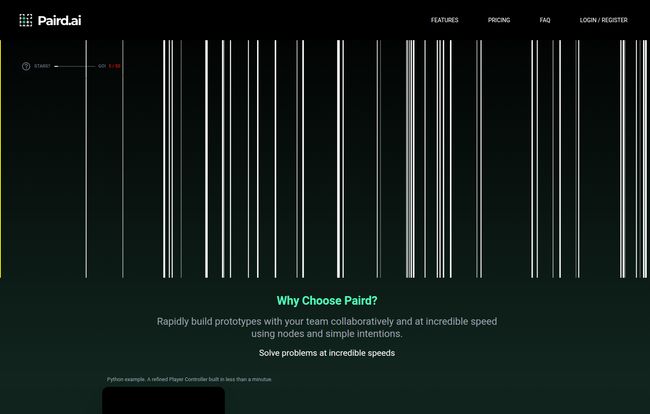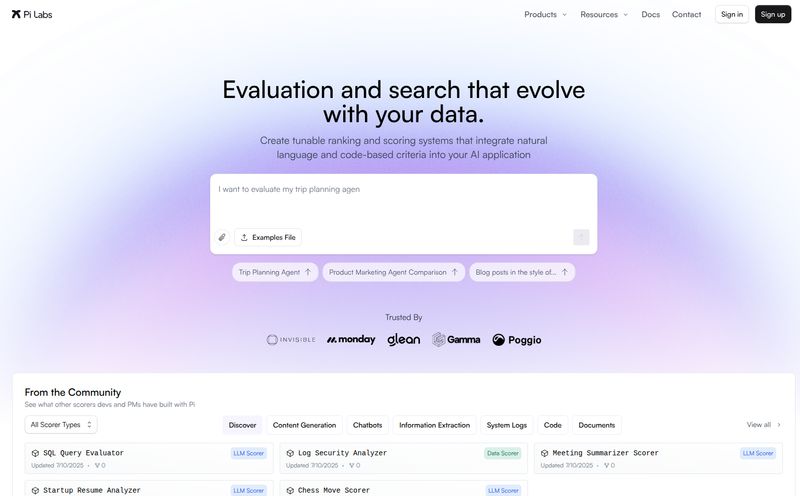For years, I've been neck-deep in the world of SEO, traffic, and the tech that drives it all. I’ve seen countless tools promise to “revolutionize” the developer workflow. Most of them are just another layer of complexity, a new dashboard to forget you have open. We've all been there, right? The promise of 10x productivity that ends up being a 0.5x time-suck trying to learn the darn thing.
So when I first stumbled upon Paird.ai, my initial reaction was a healthy dose of skepticism mixed with a tiny spark of curiosity. Another AI coding tool. Great. But then I saw their angle: "Focus on the goal, not the syntax." Now that got my attention. It’s not just about spitting out code; it’s about collaboration, speed, and a more intuitive way to build. It felt… different.
So, I rolled up my sleeves and spent some quality time with it. Is it just another flash in the AI pan, or is Paird.ai actually the collaborative coding partner we've been looking for? Let's get into it.

Visit Paird.ai
So What is Paird.ai, Really?
Imagine you have a brilliant junior developer sitting next to you. They're lightning-fast, know a dozen programming languages, but need clear direction. Now, imagine this partner is also hooked into a shared workbench where your whole team can jump in, chat, and build together in real time. That's the closest analogy I can come up with for Paird.ai.
It’s an AI-powered platform designed for two main things: generating code at an insane speed and making team collaboration ridiculously smooth. It's built on the idea of visual prompt engineering. Instead of wrestling with complex, esoteric prompts to get the AI to understand you, you build with nodes and simple goals. Think of it like a flow chart for your code's logic. You're telling the AI what to do, and it handles the how—the tedious syntax and boilerplate stuff that kills our creative momentum.
This isn't just for seasoned pros either. The platform feels accessible for newcomers looking to learn, but powerful enough for senior engineers trying to prototype a complex feature for, say, a robotics interface, as one of their testimonials from Near Earth Autonomy suggests.
The Features That Actually Matter
A feature list is just a list. What I care about is how those features impact my workflow. Here’s the stuff in Paird.ai that genuinely stood out to me.
Visual Prompting: A Different Way to Talk to AI
This is the core of Paird.ai, and honestly, it’s a game-changer. The node-based system feels like a breath of fresh air. You start with a simple goal, like "create player controller for a 3d marble game." From there, you can add nodes to refine, debug, and expand. It turns the often-frustrating process of prompt engineering into a more visual, logical exercise. It feels less like guessing a magic incantation and more like architecting a solution. This approach is brilliant for keeping the big picture in focus while letting the AI sweat the small stuff.
True Real-Time Collaboration
I've used tools that claim “real-time collaboration,” but it’s usually just a glorified Google Docs for code with a bit of lag. Paird.ai feels different. The sync and async collaboration is tight. You can literally be on a voice or video call inside the platform, editing code with a teammate, and brainstorming on the fly. It’s like a shared IDE, a Slack/Zoom call, and an AI assistant all melted into one cohesive environment. For remote teams, this could be massive for bridging that communication gap and getting back to that feeling of being in teh same room, whiteboarding ideas.
Multi-Model Magic: Not a One-Trick Pony
Here’s something for the proper tech nerds. Paird.ai isn’t locked into a single AI model. Depending on your plan, you get access to a suite of them, including OpenAI's GPT-4o-mini, Anthropic's Claude 3.5 Sonnet, and even the speed-demon Groq. Why does this matter? Because different models excel at different things. One might be better for creative Python scripting, while another is a beast at refactoring C++. Having the option to switch models gives you a level of flexibility that most other tools just don’t offer.
AI That Doesn't Just Write, It Teaches
The AI Code Scoring and Evaluation feature is more than just a linter on steroids. It provides feedback on structure, bugs, readability, and efficiency. I’ve always felt that the best way to improve is through immediate feedback loops. This feature essentially provides that. It's not just fixing your code; it's showing you why it's being fixed. For junior devs, this is an incredible learning tool. For seniors, it's a tireless peer reviewer that never gets annoyed with your late-night coding habits.
My Honest Take: The Good, The Bad, and The AI
No tool is perfect. After spending time with Paird.ai, I've definitely got my own opinions on where it shines and where it might stumble.
What I'm Genuinely Excited About is, without a doubt, the speed of iteration. The ability to go from a simple idea to a functional prototype in minutes is just... wild. The collaborative features feel truly integrated, not just bolted on. It's an environment that encourages that 'flow state' we all chase. Plus, the support for a wide range of languages, from Python and JS to Swift and even Roblox's Luau, makes it incredibly versatile.
Now for a Few Words of Caution. While the AI is a powerful partner, there's always the risk of becoming too reliant on it. It’s crucial, especially for those still learning, to understand the code being generated, not just copy-paste it. Think of it as a calculator: it's a tool to speed up the work, but you should still know how to do the math. Also, while the pricing starts incredibly generously, for heavy users or large teams on metered plans (if they go that route), costs could scale. It’s something to keep an eye on.
Breaking Down the Paird.ai Pricing
The pricing structure seems pretty well thought out, catering to different users. Let’s break it down simply. I’ve always appreciated transparent pricing, and they lay it out clearly on their site.
- Starter (Free): Honestly, this is one of the most generous free tiers I’ve seen. You get 3 projects, access to solid AI models like Claude 3.5 Sonnet and OpenAI 4o-mini, AI code scoring, and collaboration features with a 30-minute voice call limit. It’s more than enough to get a real feel for the platform without dropping a dime. No credit card required to start, which is a huge plus in my book.
- Champion ($7/month): This is the sweet spot for freelancers, serious hobbyists, and small teams. For the price of a couple of fancy coffees, you get unlimited projects, access to more powerful models (including Groq and GPT-4), AI code suggestions, a much longer 4-hour call limit, and you can add up to 5 team members. It’s an incredible value proposition.
- Enterprise ($299/year): First off, their site says this plan is 'Coming Soon'. It bundles everything from Champion and adds some serious firepower: bring your own models, white-labeling for your brand, unlimited team members, an 8-hour call limit, a training hub, and even an interactive whiteboard and a real human advisor. At $299 billed yearly, it seems almost too good to be true, but it's a powerful option for businesses that want to go all-in.
My take? Start with the free plan. There's zero risk. If you find yourself hitting the project limit or wanting those premium features, the $7 Champion plan is an absolute no-brainer.
Frequently Asked Questions about Paird.ai
What makes Paird.ai different from other AI coding tools like GitHub Copilot?
The main difference is the focus on integrated, real-time collaboration and the visual, node-based prompting system. While Copilot is an amazing autocomplete that lives in your editor, Paird.ai is a complete collaborative environment. It’s designed for teams to build together from the ground up, combining chat, video, and co-editing with AI generation.
How does the real-time collaboration actually work?
It works much like a multiplayer game or a collaborative design tool like Figma. You and your team can be in the same project space at the same time. You can see each other's cursors, edit code simultaneously, and use the built-in video, voice, and text chat to communicate. It supports both synchronous (working together at the same time) and asynchronous (leaving notes and changes for later) workflows.
Why is having multiple LLMs beneficial?
Different Large Language Models (LLMs) have unique strengths. Some are faster, some are more creative, and some are better at logical, structured code. Having access to models from OpenAI, Anthropic, and Groq allows you to pick the best tool for the specific task at hand, rather than being stuck with a one-size-fits-all solution.
Can Paird.ai help me learn to code better?
Absolutely. The AI-driven code evaluation is a fantastic learning aid. It doesn't just write code for you; it scores your work on things like efficiency and readability, offering suggestions for improvement. By studying the AI's output and feedback, you can quickly grasp best practices and new concepts.
Is Paird.ai only for teams?
Not at all! While the collaboration features are a huge selling point, it’s an incredibly powerful tool for solo developers too. The rapid prototyping, AI code generation, and multi-model support can dramatically speed up individual projects.
Final Thoughts: Is Paird.ai Worth the Hype?
After digging in, I’ve moved from skeptical to genuinely impressed. Paird.ai isn’t trying to replace developers. It’s trying to build them a better workshop. It's a tool that understands that modern development is a team sport and that the biggest bottleneck is often the friction between an idea and its first functional iteration.
It successfully blends AI-powered generation with human-centric collaboration in a way that feels intuitive and, dare I say, fun. It gets you closer to your goal faster. If you’re a developer, part of a team, or just someone who loves building cool stuff, I think you owe it to yourself to give the free tier a spin. You might just find your new favorite coding partner.
References and Sources
- Paird.ai Official Website
- Paird.ai Pricing Page
- Near Earth Autonomy (mentioned in testimonials)



